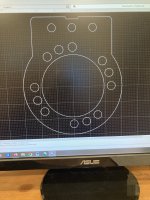FordFascist
Ford Bigot
With this setup, you would be controlling one brake at a time, disconnecting the control voltage of the one you don't use. Worst case senario, I unbolt the motor and they are normal calipers again. I plan on running The controller from post #75, so the DPDT switch only sees control voltage and the controller cuts out at 10A in each direction. It should move the motors till the limit is hit and yes, it will cycle longer. I will need to figure out how many amps that the calipers can handle and how it will affect the calipers moving that far in and out. I'm betting it's a 16A motor from some of the Ford Forums. I read that the Teslas go up to 16A as well. Willwood electric brakes have a 40A fuse.
Put me down for one.
I need a parking brake to pass state inspection. Without calipers, I'd like to be in $100 in controlling cutting/parking brakes.
You probably want to play with these a bit more. For clamping the 10A limit switch will work, but the issue is topping out the jackscrew in reverse isn't good for these things. You also will have a long time to make the brake work when you try to re-engage it. You need to monitor amperage for engagement and timed for disengagement.
You don't just remove the motor on these to make it work like a hydraulic caliper again. I'm not sure where you are getting that from. You have to back the e-brake mechanism off and it's easiest to do with the motor.
TL;DR you are going to need a controller for these calipers unless you want to risk frying them.




